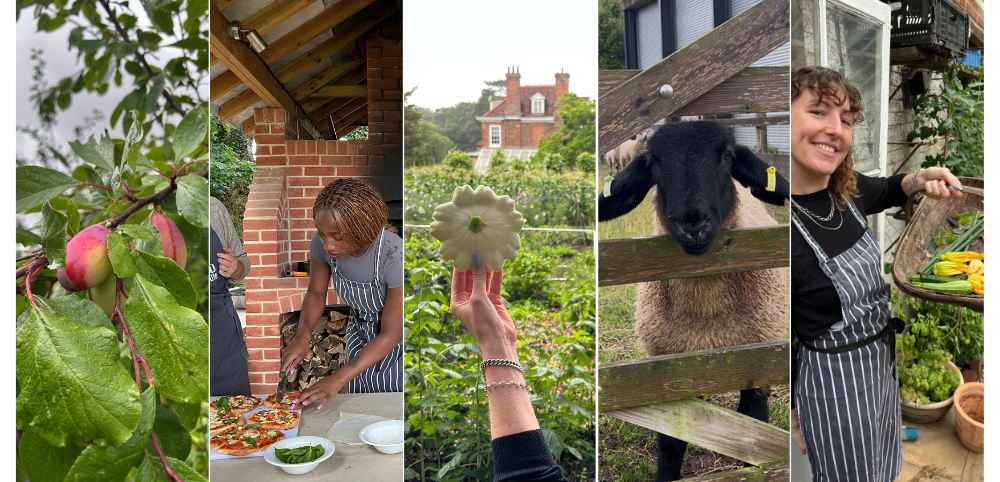Read about one of our Young Leaders reflections on our recent team day out to The Food Museum in Stowmarket.
By Lottie Huber
This article was written by one of our Young Leaders, Lottie Huber. Through Eat Club’s year-long Young Leaders Programme, 16–25-year-olds gain hands-on experience, mentorship, and career skills while shaping how we serve London’s youth and communities.
A little over an hour from London, The Food Museum in Stowmarket was the perfect choice for Eat Club’s team day out. Established in 1967 as the Museum of East Anglia Life, it rebranded in 2022 as the UK’s only food museum, dedicated to improving the public’s understanding of where our food comes from, the history of food production, and our impact on the environment. It’s a large site with a wide range of activities on offer, including daily workshops, tours, exhibitions, and regular events.
It was a typical rainy day when we arrived, but we started with a pizza making workshop which made up for it. The best part was that you could pick which toppings you’d like from the Museum’s beautiful walled garden. There were so many vegetables, fruits and herbs to pick for our toppings, so we were spoilt for choice. We ended up picking courgettes, tomatoes, oregano, potatoes, sage, basil and patty pan squash. It was so satisfying to pick a vegetable from the ground, cook it and eat it within the hour. It’s so important that children also gain this experience of understanding where our food comes from.
We then made our way to an insightful exhibition about the history of school food and how it has changed over the years, reflecting political and financial factors. People can write down and share their memories of their school dinners, which was funny as chips were mentioned multiple times, but also quite sad to read as people of all ages seemed to have a shared dislike for the quality of food.
As you explore the exhibition, you’ll discover the fascinating story of school meals through a timeline. It begins in the 19th century and moves into the 1940s–1980s, when a push for improved nutritional standards led to the first National School Meals Policy in 1941! However, from the 1980s onwards, a growing emphasis on commercial involvement created a market for school food. This new focus on profit led to a dramatic fall in standards, a trend challenged by later campaigns (like Jamie’s!). You’ll also learn about landmark policies like the Milk in Schools scheme, which gave a free third of a pint of milk to poor and malnourished children each day. The programme’s end about 30 years later under a Conservative government earned Margaret Thatcher the famous nickname ‘Milk Snatcher.’
The timeline also explores more recent efforts to improve school food. These include Jamie Oliver’s School Dinners campaign in 2005, Marcus Rashford’s 2020 push for food vouchers for children eligible for free school meals, and the development of the largely ignored National Food Strategy. While great progress has been made in improving the nutritional standards and accessibility of school food, it’s clear there is still much more to be done.
One particular quote from Dame Prue Leith resonated with us deeply: “I cannot think of anything more important than making sure that what our children eat is good for them and that they like it. What could be more important than training our children to like good, healthy, delicious food?”
Working with Eat Club has shown us firsthand how crucial cooking is as a life skill—for your health, future career, and financial well-being. This is a skill that is essential to prioritise. It’s only when food education and healthy eating become a core part of the UK’s governments agenda that we can truly prioritise public health and reduce the £67.5 billion of NHS money directly spent on non-communicable diseases caused by poor diet (FFCC, 2024).
Next on our agenda was plum picking. On our way to the plum trees, we saw many farm animals such as sheep, pigs, chickens, a turkey, goats, and horses. The Museum offers daily animal feeding sessions, but it wasn’t time for it yet, much to the dismay of the sheep. We spent some time picking ripe plums from the trees, and it was impossible not to snack on them throughout.
Lastly, we couldn’t leave without looking through the shop. They sell fresh produce grown and harvested from the Museum’s Garden. I bought a few courgettes and the best apple juice I’ve had in a long time, which was made from apples grown in Suffolk and pressed at the Museum. The pizza workshop for me was the highlight of the day, as our pizza’s turned out delicious and it was so fulfilling to eat fresh locally grown food. I would strongly recommend a trip to The Food Museum to learn about the connection between food and our daily lives.
Find out more at The Food Museum. The exhibition School Dinners runs from 2 April 2025 to 25 February 2027.

